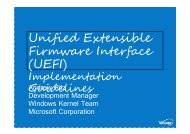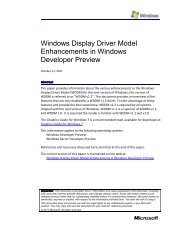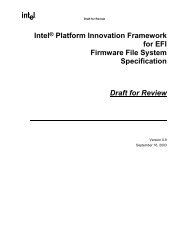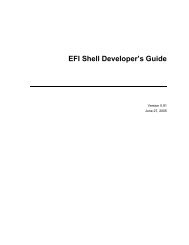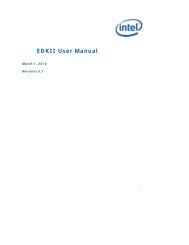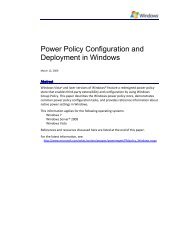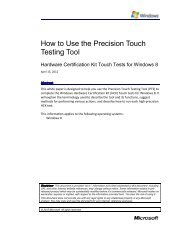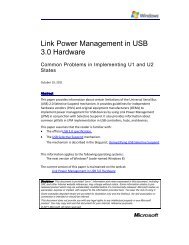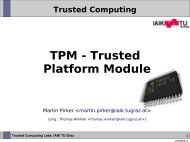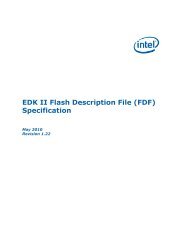Acpi.pdf - Firmware Encoding Index
Acpi.pdf - Firmware Encoding Index
Acpi.pdf - Firmware Encoding Index
- No tags were found...
You also want an ePaper? Increase the reach of your titles
YUMPU automatically turns print PDFs into web optimized ePapers that Google loves.
Draft for ReviewIntel ® Platform Innovation Frameworkfor EFIACPI SpecificationDraft for ReviewVersion 0.9April 1, 2004
ACPI SpecificationDraft for ReviewTHIS SPECIFICATION IS PROVIDED "AS IS" WITH NO WARRANTIES WHATSOEVER, INCLUDING ANY WARRANTYOF MERCHANTABILITY, NONINFRINGEMENT, FITNESS FOR ANY PARTICULAR PURPOSE, OR ANY WARRANTYOTHERWISE ARISING OUT OF ANY PROPOSAL, SPECIFICATION OR SAMPLE. Except for a limited copyright licenseto copy this specification for internal use only, no license, express or implied, by estoppel or otherwise, to any intellectualproperty rights is granted herein.Intel disclaims all liability, including liability for infringement of any proprietary rights, relating to implementation of informationin this specification. Intel does not warrant or represent that such implementation(s) will not infringe such rights.Designers must not rely on the absence or characteristics of any features or instructions marked "reserved" or "undefined."Intel reserves these for future definition and shall have no responsibility whatsoever for conflicts or incompatibilities arisingfrom future changes to them.This document is an intermediate draft for comment only and is subject to change without notice. Readers should not designproducts based on this document.Intel, the Intel logo, and Itanium are trademarks or registered trademarks of Intel Corporation or its subsidiaries in the UnitedStates and other countries.* Other names and brands may be claimed as the property of others.Copyright © 2000–2004, Intel Corporation.Intel order number xxxxxx-001ii April 2004 Version 0.9
ACPI SpecificationDraft for Reviewiv April 2004 Version 0.9
Draft for ReviewContents1 Introduction ...................................................................................................... 7Overview ................................................................................................................................. 7Scope...................................................................................................................................... 7Conventions Used in This Document...................................................................................... 7Data Structure Descriptions ........................................................................................... 7Protocol Descriptions ..................................................................................................... 8Procedure Descriptions.................................................................................................. 9Pseudo-Code Conventions ............................................................................................ 9Typographic Conventions............................................................................................... 92 Design Discussion ......................................................................................... 11ACPI Terms........................................................................................................................... 11ACPI Overview...................................................................................................................... 12Rationale............................................................................................................................... 13Rationale ......................................................................................................................13Name Space Collisions ................................................................................................ 13ACPI Specification Compliance.................................................................................... 13Complexity of Dynamically Generated AML................................................................. 14Limitations of Modular AML.......................................................................................... 14Requirements........................................................................................................................ 14ACPI Support Driver.............................................................................................................. 14Introduction .................................................................................................................. 14Dependency Resolution ............................................................................................... 14ACPI Support Protocol ................................................................................................. 15ACPI Platform Driver............................................................................................................. 15Introduction .................................................................................................................. 15Dependency Resolution ............................................................................................... 15Driver Execution........................................................................................................... 16Platform Policy ............................................................................................................. 16System Sleep States.............................................................................................................17Considerations for the Itanium® Processor Family............................................................... 18ACPI Compliance......................................................................................................... 18Operating System Implementations ............................................................................. 183 Code Definitions............................................................................................. 19Introduction ........................................................................................................................... 19ACPI Support Protocol..........................................................................................................19EFI_ACPI_SUPPORT_PROTOCOL............................................................................ 19EFI_ACPI_SUPPORT_PROTOCOL.Get<strong>Acpi</strong>Table()................................................... 21EFI_ACPI_SUPPORT_PROTOCOL.Set<strong>Acpi</strong>Table()................................................... 23EFI_ACPI_SUPPORT_PROTOCOL.PublishTables().................................................. 25Version 0.9 April 2004 v
ACPI SpecificationDraft for ReviewTablesTable 2-1. Supported ACPI System Sleep States .......................................................... 17vi April 2004 Version 0.9
Draft for Review1IntroductionOverviewScopeThis specification describes one design for supporting the Advanced Configuration and PowerInterface Specification (hereafter referred to as the “ACPI specification”), revisions 1.0b and 2.0, inthe Intel® Platform Innovation Framework for EFI (hereafter referred to as the "Framework"). TheACPI specification details system configuration and power management information.This specification does the following:• Describes the basic components of the Framework ACPI design, the ACPI support driver, andthe ACPI platform driver• Describes additional ACPI considerations for the Itanium® processor family• Provides code definitions for the ACPI Support Protocol and other ACPI-related typedefinitions that are architecturally required by the Intel® Platform Innovation Framework forEFI Architecture SpecificationSee Industry Specifications in the Framework master help system for the URL for the ACPIspecification.This specification provides a design for supporting the ACPI 1.0b and 2.0 specifications in aFramework environment.Conventions Used in This DocumentThis document uses the typographic and illustrative conventions described below.Data Structure DescriptionsIntel ® processors based on 32-bit Intel ® architecture (IA-32) are “little endian” machines. Thisdistinction means that the low-order byte of a multibyte data item in memory is at the lowestaddress, while the high-order byte is at the highest address. Processors of the Intel ® Itanium ®processor family may be configured for both “little endian” and “big endian” operation. Allimplementations designed to conform to this specification will use “little endian” operation.In some memory layout descriptions, certain fields are marked reserved. Software must initializesuch fields to zero and ignore them when read. On an update operation, software must preserveany reserved field.Version 0.9 April 2004 7
ACPI SpecificationDraft for ReviewThe data structures described in this document generally have the following format:STRUCTURE NAME: The formal name of the data structure.Summary:Prototype:Parameters:Description:Related Definitions:Protocol DescriptionsA brief description of the data structure.A “C-style” type declaration for the data structure.A brief description of each field in the data structure prototype.A description of the functionality provided by the data structure,including any limitations and caveats of which the caller shouldbe aware.The type declarations and constants that are used only bythis data structure.The protocols described in this document generally have the following format:Protocol Name: The formal name of the protocol interface.Summary:GUID:A brief description of the protocol interface.The 128-bit Globally Unique Identifier (GUID) for the protocolinterface.Protocol Interface Structure:A “C-style” data structure definition containing the proceduresand data fields produced by this protocol interface.Parameters:Description:Related Definitions:A brief description of each field in the protocol interfacestructure.A description of the functionality provided by the interface,including any limitations and caveats of which the caller shouldbe aware.The type declarations and constants that are used in the protocolinterface structure or any of its procedures.8 April 2004 Version 0.9
Draft for Review IntroductionProcedure DescriptionsThe procedures described in this document generally have the following format:ProcedureName(): The formal name of the procedure.Summary:Prototype:Parameters:Description:Related Definitions:A brief description of the procedure.A “C-style” procedure header defining the calling sequence.A brief description of each field in the procedure prototype.A description of the functionality provided by the interface,including any limitations and caveats of which the caller shouldbe aware.The type declarations and constants that are used only bythis procedure.Status Codes Returned: A description of any codes returned by the interface. Theprocedure is required to implement any status codes listed in thistable. Additional error codes may be returned, but they will notbe tested by standard compliance tests, and any software thatuses the procedure cannot depend on any of the extended errorcodes that an implementation may provide.Pseudo-Code ConventionsPseudo code is presented to describe algorithms in a more concise form. None of the algorithms inthis document are intended to be compiled directly. The code is presented at a level correspondingto the surrounding text.In describing variables, a list is an unordered collection of homogeneous objects. A queue is anordered list of homogeneous objects. Unless otherwise noted, the ordering is assumed to be First InFirst Out (FIFO).Pseudo code is presented in a C-like format, using C conventions where appropriate. The codingstyle, particularly the indentation style, is used for readability and does not necessarily comply withan implementation of the Extensible <strong>Firmware</strong> Interface Specification.Typographic ConventionsThis document uses the typographic and illustrative conventions described below:Plain textThe normal text typeface is used for the vast majority of the descriptivetext in a specification.Plain text (blue) In the online help version of this specification, any plain text that isunderlined and in blue indicates an active link to the cross-reference.Click on the word to follow the hyperlink. Note that these links are notactive in the PDF of the specification.Version 0.9 April 2004 9
ACPI SpecificationDraft for ReviewBoldItalicIn text, a Bold typeface identifies a processor register name. In otherinstances, a Bold typeface can be used as a running head within aparagraph.In text, an Italic typeface can be used as emphasis to introduce a newterm or to indicate a manual or specification name.BOLD Monospace Computer code, example code segments, and all prototype codesegments use a BOLD Monospace typeface with a dark red color.These code listings normally appear in one or more separate paragraphs,though words or segments can also be embedded in a normal textparagraph.Bold Monospace In the online help version of this specification, words in aBold Monospace typeface that is underlined and in blue indicate anactive hyperlink to the code definition for that function or type definition.Click on the word to follow the hyperlink. Note that these links are notactive in the PDF of the specification. Also, these inactive links in thePDF may instead have a Bold Monospace appearance that isunderlined but in dark red. Again, these links are not active in the PDF ofthe specification.Italic Monospace In code or in text, words in Italic Monospace indicate placeholdernames for variable information that must be supplied (i.e., arguments).Plain Monospace In code, words in a Plain Monospace typeface that is a dark redcolor but is not bold or italicized indicate pseudo code or example code.These code segments typically occur in one or more separate paragraphs.text text textIn the PDF of this specification, text that is highlighted in yellowindicates that a change was made to that text since the previous revisionof the PDF. The highlighting indicates only that a change was madesince the previous version; it does not specify what changed. If text wasdeleted and thus cannot be highlighted, a note in red and highlighted inyellow (that looks like (Note: text text text.)) appears where the deletionoccurred.See the master Framework glossary in the Framework Interoperability and ComponentSpecifications help system for definitions of terms and abbreviations that are used in this documentor that might be useful in understanding the descriptions presented in this document.See the master Framework references in the Interoperability and Component Specifications helpsystem for a complete list of the additional documents and specifications that are required orsuggested for interpreting the information presented in this document.The Framework Interoperability and Component Specifications help system is available at thefollowing URL:http://www.intel.com/technology/framework/spec.htm10 April 2004 Version 0.9
Draft for ReviewACPI Terms2Design DiscussionThe following terms are used throughout this specification or else are not widely used in otherFramework specifications. See the master Glossary in the master help system for definitions ofadditional terms.ACPIAdvanced Configuration and Power Interface.AMLACPI Machine Language.APICAdvanced Programmable Interrupt Controller.ASLACPI Source Language.DSDTDifferentiated System Description Table.EBDAExtended BIOS Data Area.FACS<strong>Firmware</strong> ACPI Control Structure.FADTFixed ACPI Description Table.GPIOGeneral Purpose Input/Output.MADTMultiple APIC Description Table.PMIPlatform Management Interrupt.RSD_PTRRoot System Description Pointer.RSDTRoot System Description Table.Version 0.9 April 2004 11
ACPI SpecificationDraft for ReviewSMISSDTSxXSDTSystem Management Interrupt.Secondary System Description Table.(Where x is a whole number from 1 to 5). Indicates the sleeping state of the system. See theACPI industry specification for more information.Extended System Description Table.ACPI OverviewThe Framework ACPI design separates common ACPI requirements from platform-specific ACPIrequirements into different drivers to do the following:• Maximize the reuse of support code• Isolate the code that must be rewritten on a per-platform basisTo make an ACPI-compliant system, firmware must produce ACPI tables and report the ACPImemory usage to the operating system’s EFI memory map reporting mechanisms (or via theINT 15 function E820h for legacy systems). The firmware may also be required to implement thefollowing:• Some processor-architecture-specific (System Management Interrupt [SMI]/PlatformManagement Interrupt [PMI]) code to support transitioning between legacy and ACPI modes• A boot path to support S2/S3 resumeThis specification describes a mechanism to accomplish these things. It divides the tasks into thefollowing two components:• ACPI support driver• ACPI platform driverThe ACPI platform driver could actually be composed of several disparate drivers, but for the sakeof this specification, it is assumed to be a single driver.The ACPI support driver is generic and should be usable in widely varying platforms withoutmodification. Its primary function is to control where in memory the ACPI tables are copied andto ensure that all ACPI tables have correct address links and checksums. The ACPI support driveralso does the following:• Creates generic tables such as the Root System Description Pointer (RSD_PTR), Root SystemDescription Table (RSDT), and Extended System Description Table (XSDT) structures (see theACPI industry specification for descriptions of these structures)• Must publish the EFI_ACPI_SUPPORT_PROTOCOL, which is used by the ACPI platformdriver12 April 2004 Version 0.9
Draft for Review Design DiscussionAll platform differentiation with respect to ACPI occurs in the ACPI platform driver. The ACPIplatform driver is responsible for the following:• Producing all ACPI tables other than RSD_PTR, RSDT, and XSDT• Installing any required SMI/PMI handlers• Supporting any platform-specific sleep state requirements• Generating the hardware signatureThe ACPI platform driver may optionally publish interfaces to support sleep states.RationaleRationaleThe Framework strives to allow independent development and linking of components. While itwould be nice to extend this idea to the ACPI name space and the ACPI Machine Language (AML)code, there are at least four reasons why this approach is not desirable:• Name space collisions• Compliance with the ACPI specification• The complexity of dynamically generated AML• Limitations of modular AMLThe following topics discuss these reasons in detail.Name Space CollisionsNames in the ACPI name space are only four characters long. Each name must be unique inits scope. There is no way to guarantee that names will be unique if ACPI Machine Language(AML) is provided from different sources. The ACPI Source Language (ASL) code must beavailable to ensure there are no name collisions.ACPI Specification ComplianceACPI is intended to replace nearly all BIOS interfaces for configuration, power management, andmost things that are platform specific in nature. As of version 1.0b of the ACPI specification, manyareas remain unclear. The specification is conspicuously quiet when it comes to defining roles andresponsibilities for BIOS and operating system code. Because of these weaknesses, ACPIcompliance is essentially the intersection of the following:• ACPI specification• Output of the Microsoft* ACPI Source Language (ASL) compiler• Microsoft* ACPI implementation requirements for the Windows* 98 and Windows 2000operating systemsThis intersection results in a constantly evolving set of requirements to which firmware writersneed to conform. The Framework ACPI design allows for updating ACPI tables individuallywithout requiring a full BIOS update.If ACPI Machine Language (AML) was provided as precompiled modules from different sources,as Driver Execution Environment (DXE) drivers are, it would be impossible to make changes tomeet the changing requirements for ACPI compliance.Version 0.9 April 2004 13
ACPI SpecificationDraft for ReviewComplexity of Dynamically Generated AMLOne possible solution to the problem would be to dynamically generate the name space from metadata that was provided in lieu of ACPI Machine Language (AML). The most immediate problemwith this approach is that the code that is required to generate and parse an ACPI name space islarge and complex. Because the Framework is intended to be system firmware, available space forcode storage will be very limited.Limitations of Modular AMLBecause the ACPI name space is inherently platform specific, it is nearly impossible to writecorrect ACPI Source Language (ASL) code without knowing the platform specifics.For example: A silicon vendor could supply a chunk of ACPI Machine Language (AML) in theform of a Secondary System Description Table (SSDT), which could be loaded into the namespace. However, the vendor could not possibly know how their chip was hooked up. What eventswere connected to which General Purpose Input/Output (GPIO)? The complexity of theseproblems likely makes this solution impossible.RequirementsThis Framework ACPI design must meet the following requirements:• All aspects of this design must be compliant with the following:⎯ Intel® Platform Innovation Framework for EFI Architecture Specification, version 0.9⎯ Intel® Platform Innovation Framework for EFI Driver Execution Environment CoreInterface Specification (DXE CIS), version 0.9⎯ ACPI 2.0 specification• The design must enable size efficiency, code reuse, and maintainability.• It must be possible to access platform policy data from ACPI Machine Language (AML) code.For example, selections the user has made from a Setup application can be taken into accountby control methods.ACPI Support DriverIntroductionThe ACPI support driver is responsible for managing the memory map with regard to the ACPItables. It also provides checksum services, creates some required tables (Root System DescriptionPointer [RSD_PTR], Root System Description Table [RSDT], Extended System Description Table[XSDT]), and updates Fixed ACPI Description Table (FADT) addresses.The ACPI support driver also publishes the ACPI tables in the EFI Configuration Table.Dependency ResolutionThe ACPI support driver requires only DXE Services. In other words, dispatch of the ACPI supportdriver is not dependent on any particular platform protocols.14 April 2004 Version 0.9
Draft for Review Design DiscussionACPI Support ProtocolSee Code Definitions for the definition of the ACPI Support Protocol, which is the protocoldefinition that applies to the ACPI support driver.ACPI Platform DriverIntroductionThe ACPI platform driver loads the ACPI tables. The driver relies on services provided byEFI_ACPI_SUPPORT_PROTOCOL, which is defined in Code Definitions.ACPI requires a hardware signature to be generated by the Framework and written into the<strong>Firmware</strong> ACPI Control Structure (FACS) during each boot and each S4 resume. The hardwaresignature is intended to be a flag to the operating system that some hardware configuration haschanged and the operating system must perform a cold boot. If the operating system is resumingfrom the S4 sleep state and it detects that the hardware signature has changed, it may abort theresume and do a cold boot instead. There is no meaning to the actual value of the signature, onlywhether it has changed from the previous boot. The ACPI platform driver is responsible forcreating the hardware signature.In addition, the ACPI platform driver must install any System Management Interrupt (SMI) orPlatform Management Interrupt (PMI) support that is required by the ACPI specification. If the S3sleep state is supported, the ACPI platform driver may also produceEFI_BOOT_SCRIPT_SAVE_PROTOCOL; see the Intel® Platform Innovation Framework for EFIBoot Script Specification for more details.The ACPI platform driver may also complete additional platform-specific tasks. An example isupdating the status of processors in the Multiple APIC Description Table (MADT) structure.The driver is also responsible for determining which versions of the ACPI tables should bepublished by the ACPI support driver.Dependency ResolutionThe ACPI platform driver requires the following to allocate memory for the tables and updatetables accordingly:• DXE Services• EFI_ACPI_SUPPORT_PROTOCOLThe ACPI platform driver may require some chipset code to switch into and out of ACPI mode.Because this code is likely to run in System Management Mode (SMM) context, it must be linked(or loaded) in such a way as to allow it to exist in the SMM address range. Furthermore, it must notcall out into non-SMM code.The ACPI platform driver may have additional platform-specific requirements for obtaininginformation to determine table contents.Version 0.9 April 2004 15
ACPI SpecificationDraft for ReviewDriver ExecutionDriver ExecutionThe ACPI platform driver is responsible for loading all tables that are required for a platform ACPIimplementation using the EFI_ACPI_SUPPORT_PROTOCOL.Set<strong>Acpi</strong>Table() API.Driver execution impacts the following:• Table Selection• SMI ImplicationsTable SelectionA given implementation of the ACPI platform driver may have a variety of ACPI tables from whichto choose when adding tables. It must be able to determine the correct set of tables to report. Forexample, whether or not to load a Secondary System Description Table (SSDT) for S3 supportmight depend on an environment variable that is used to toggle S3 support for the system.SMI ImplicationsIA-32 platforms may require System Management Interrupt (SMI) code for switching betweenlegacy and ACPI operation modes and for handling global locks. This code will be registered withthe SMI handler using the SMI protocol. Itanium®-based systems may require similar PlatformManagement Interrupt (PMI) code.Platform PolicyIn the context of the Framework, ACPI platform policy is defined to be any data that is to beconsumed by either of the following:• ACPI initialization code• The ACPI Machine Language (AML) control methods themselvesFor example, if a user disables a COM port using the Framework Setup utility, the _STA controlmethod for that COM port could report it as "not present" to the operating system. This methodwould enable selections that were made in the Framework Setup utility to remain true in the contextof the operating system. The policy data in this case is "COM port disabled."Typically, this type of information has been stored in CMOS. Unless the chipset hardware providesan alternate access mechanism to read CMOS, there may be synchronization issues between theAML code and other software that is attempting to access CMOS at the same time.Instead of using CMOS to report these types of details to AML code, the Framework will use aSecondary System Description Table (SSDT) to communicate policy data. The ACPI platformdriver will load the correct SSDT. AML that needs access to policy data will reference this policydata using its name in the name space.16 April 2004 Version 0.9
Draft for Review Design DiscussionSystem Sleep StatesThe table below describes the ACPI system sleep states that are supported in the Framework ACPIdesign.Table 2-1. Supported ACPI System Sleep StatesACPI SleepStateSupported? NotesS1YesS2 Yes Same as S3.Pre-sleep: The Framework supports _PTS as necessary.Post-sleep:• The Framework supports _WAK as necessary.• Nothing is required from the Framework. Waking is completely underthe control of the operating system because resume occurs in theoperating system rather than the reset vector.S3S4YesYesS3 resume is a special boot path that causes the Pre-EFI Initialization (PEI)phase to take different actions compared to a normal boot. Information mustbe saved by DXE during a normal boot that is retrieved by PEI during an S3resume boot. See the Intel® Platform Innovation Framework for EFI S3Resume Boot Path Specification for details on implementing S3 support.Pre-sleep: The Framework supports _PTS as necessary.Post-sleep:• The Framework calculates the hardware signature.• Normal POST except the EFI boot manager is bypassed and theoperating system loader is invoked directly.• The Framework supports _WAK as necessary.S4BIOS No Framework support for S4BIOS is not defined.Version 0.9 April 2004 17
ACPI SpecificationDraft for ReviewConsiderations for the Itanium® Processor FamilyACPI ComplianceEarly versions of ACPI implementations for the Itanium® processor family supported aspecification called IA64 Extensions to the ACPI specification. This specification is obsolete andhas been superceded by the ACPI 2.0 specification. Framework-compliant systems must notsupport the IA64 Extensions to the ACPI specification and instead must comply with the ACPI 2.0specification.Operating System ImplementationsOperating System ImplementationsThere are several differences between the operating system implementations for the Itanium®processor family, which are all EFI aware, and the operating system implementations for IA-32processors, of which some are EFI aware and others are not. The differences that are encountereddepend on whether the target operating system is EFI aware. Following are some of thesedifferences, which are also described in the next topics:• The mechanism for locating the RSD_PTR structure• The mechanism for retrieving the memory mapLocating the RSD_PTR StructureLegacy (non-EFI-aware IA-32) operating systems locate the Root System Description Pointer(RSD_PTR) structure by scanning for the RSD_PTR signature in the Extended BIOS Data Area(EBDA) and BIOS areas between E0000h and FFFFF on 16-byte boundaries.EFI-aware operating systems (all Itanium®-based systems and EFI-aware IA-32) locate theRSD_PTR structure by looking up its physical address in the EFI System Table. The ACPI supportdriver is responsible for updating the EFI System Table.Retrieving the Memory MapNon-EFI-aware operating systems use the INT 15h function E820h to retrieve the system memorymap. This retrieval must be handled by the legacy operating system boot code.EFI-aware operating systems use the EFI Boot Service GetMemoryMap() to retrieve the systemmemory map. EFI Boot Services will properly report this information with no additional actionsbeing required of the ACPI support driver.18 April 2004 Version 0.9
Draft for ReviewIntroduction3Code DefinitionsThis section contains the basic definitions for the Framework ACPI design. The following protocolis defined in this section:• EFI_ACPI_SUPPORT_PROTOCOLThis section also contains the definitions for additional data types and structures that aresubordinate to the structures in which they are called. The following data type can be found in"Related Definitions" of the parent function definition:• EFI_ACPI_TABLE_VERSIONACPI Support ProtocolEFI_ACPI_SUPPORT_PROTOCOLSummaryThis protocol provides some basic services to support publishing ACPI system tables. Theservices handle many of the more mundane tasks that are required to publish a set of tables. Theservices will do the following:• Generate common tables.• Update the table links.• Ensure that tables are properly aligned and use correct types of memory.• Update checksum values and IDs.• Complete the final installation of the tables.GUID#define EFI_ACPI_SUPPORT_GUID \{ 0xdbff9d55, 0x89b7, 0x46da, 0xbd, 0xdf, 0x67, 0x7d, 0x3d, 0xc0,0x24, 0x1d }Protocol Interface Structuretypedef struct _EFI_ACPI_SUPPORT_PROTOCOL {EFI_ACPI_GET_ACPI_TABLE Get<strong>Acpi</strong>Table;EFI_ACPI_SET_ACPI_TABLE Set<strong>Acpi</strong>Table;EFI_ACPI_PUBLISH_TABLES PublishTables;} EFI_ACPI_SUPPORT_PROTOCOL;Version 0.9 April 2004 19
ACPI SpecificationDraft for ReviewParametersDescriptionGet<strong>Acpi</strong>TableReturns a table specified by an index if it exists. See the Get<strong>Acpi</strong>Table()function description.Set<strong>Acpi</strong>TableAdds, removes, or updates ACPI tables. See the Set<strong>Acpi</strong>Table() functiondescription.PublishTablesPublishes the ACPI tables. See the PublishTables() function description.The EFI_ACPI_SUPPORT_PROTOCOL is published by the ACPI support driver and contains allthe platform-independent interfaces that are used by the ACPI platform driver. The ACPI supportdriver’s primary responsibility is to provide support functionality for the ACPI platform driver.The ACPI support driver must produce and maintain valid structures for the following:• Root System Description Pointer (RSD_PTR)• Root System Description Table (RSDT)• Extended System Description Table (XSDT)See the ACPI specification for descriptions of these structures. They must be allocated frommemory of type EfiACPIReclaimMemory. At all times, they must contain up-to-date pointersto existing tables.The ACPI support driver maintains a list of tables that belong to each version of ACPI that issupported. Each version will have RSD_PTR, RSDT, and XSDT structures that are created by thedriver. The one exception is the "none" version, which can be used to add items that do not belongto one of the other versions. Tables can be added to one or more versions of ACPI.The ACPI support driver adds the RSD_PTR address to the EFI System Table, with the GUID thatis defined in the ACPI specification, when another module (typically the ACPI platform driver)calls the EFI_ACPI_SUPPORT_PROTOCOL.PublishTables(). The ACPI support driveradds the RSD_PTR address to the EFI System Table using the PublishTables() function.NOTELegacy ACPI operating systems (non-EFI-aware IA-32) search for the RSD_PTR signature, whichis located either in the Extended BIOS Data Area (EBDA) or between E0000 and FFFFF. Legacyoperating system code may have to ensure that RSD_PTR is copied or moved to a proper location.All physical addresses that are specified in the Fixed ACPI Description Table (FADT) structureneed to be updated to reflect the actual table locations. The FADT needs the address of the<strong>Firmware</strong> ACPI Control Structure (FACS) and Differentiated System Description Table (DSDT)updated in the ACPI 1.0 and ACPI 2.0 portion of the table. The driver will have to update theseaddresses as tables are added and removed.20 April 2004 Version 0.9
Draft for Review Code DefinitionsEFI_ACPI_SUPPORT_PROTOCOL.Get<strong>Acpi</strong>Table()SummaryReturns a requested ACPI table.PrototypetypedefEFI_STATUSEFI_BOOTSERVICE(EFIAPI *EFI_ACPI_GET_ACPI_TABLE) (IN EFI_ACPI_SUPPORT_PROTOCOL *This,IN INTN<strong>Index</strong>,OUT VOID**Table,OUT EFI_ACPI_TABLE_VERSION *Version,OUT UINTN*Handle);ParametersThisA pointer to the EFI_ACPI_SUPPORT_PROTOCOL instance.<strong>Index</strong>The zero-based index of the table to retrieve.TablePointer for returning the table buffer.VersionUpdated with the ACPI versions to which this table belongs. TypeEFI_ACPI_TABLE_VERSION is defined in "Related Definitions" below.HandlePointer for identifying the table.DescriptionThe Get<strong>Acpi</strong>Table() function returns a buffer containing the ACPI table associated with the<strong>Index</strong> that was input. The following structures are not considered elements in the list of ACPItables:• Root System Description Pointer (RSD_PTR)• Root System Description Table (RSDT)• Extended System Description Table (XSDT)The EFI_ACPI_SUPPORT_PROTOCOL instance allocates a buffer for returning a copy of thetable from EFI Boot Services memory, and this buffer must be freed by the caller. Table will notpoint to the actual copy of the table.Version 0.9 April 2004 21
ACPI SpecificationDraft for ReviewHandle is a UINTN that is used to identify the table for use with theEFI_ACPI_SUPPORT_PROTOCOL.Set<strong>Acpi</strong>Table() function. The meaning of the value isimplementation specific and cannot be used as anything more than an identifier for the table.Version is updated with a bit map containing all the versions of ACPI of which the tableis a member.Related Definitions//// ACPI Version bit map definition://// EFI_ACPI_VERSION_1_0b – ACPI Version 1.0b// EFI_ACPI_VERSION_2_0 – ACPI Version 2.0// EFI_ACPI_VERSION_NONE – No ACPI Versions. This might be used// to create memory-based operation regions or other information// that is not part of the ACPI “tree” but must still be found// in ACPI memory space and/or managed by the core ACPI driver.//// Note that EFI provides discrete GUIDs for each version of ACPI// that is supported. It is expected that each EFI GUIDed// version of ACPI will also have a corresponding bit map// definition. This allows maintenance of separate ACPI trees// for each distinctly different version of ACPI.////*****************************************************// EFI_ACPI_TABLE_VERSION//*****************************************************#define EFI_ACPI_TABLE_VERSIONUINT32#define EFI_ACPI_TABLE_VERSION_NONE (1
Draft for Review Code DefinitionsEFI_ACPI_SUPPORT_PROTOCOL.Set<strong>Acpi</strong>Table()SummaryUsed to add, remove, or update ACPI tables.PrototypetypedefEFI_STATUSEFI_BOOTSERVICE(EFIAPI *EFI_ACPI_SET_ACPI_TABLE) (IN EFI_ACPI_SUPPORT_PROTOCOL *This,IN VOID *Table OPTIONAL,IN BOOLEANChecksum,IN EFI_ACPI_TABLE_VERSION Version,IN OUT UINTN*Handle);ParametersThisA pointer to the EFI_ACPI_SUPPORT_PROTOCOL instance.TablePointer to the new table to add or update.ChecksumIf TRUE, indicates that the checksum should be calculated for this table.VersionIndicates to which version(s) of ACPI the table should be added. TypeEFI_ACPI_TABLE_VERSION is defined inEFI_ACPI_SUPPORT_PROTOCOL.Get<strong>Acpi</strong>Table().HandlePointer to the handle of the table to remove or update.DescriptionThe Set<strong>Acpi</strong>Table() function adds, updates, or removes ACPI tables. If *Handle is zero andTable is not NULL, the function will add the table to the ACPI "trees" that are specified byVersion. If *Handle is not zero and Table is not NULL, the table(s) indicated by Handle andVersion will be updated with the new table. If *Handle is not zero and Table is NULL, thetable(s) identified by the handle and Version will be removed. If *Handle is zero and Table isNULL, EFI_INVALID_PARAMETER will be returned.All tables that are added must be copied to memory of type EfiACPIReclaimMemory, exceptfor the <strong>Firmware</strong> ACPI Control Structure (FACS), which must be of type EfiACPIMemoryNVS.The FACS must also be aligned on a 64-byte address boundary.Version 0.9 April 2004 23
ACPI SpecificationDraft for ReviewChecksum values for tables and structures must be calculated and put in place in compliance withthe ACPI specification. Checksum will indicate which tables need their checksums updated.Additionally, the ACPI support driver must update any tables that it modifies as tables are addedand removed, specifically the following:• Root System Description Pointer (RSD_PTR)• Root System Description Table (RSDT)• Extended System Description Table (XSDT)• Fixed ACPI Description Table (FADT)The Version parameter is used to determine in which ACPI version a given table shouldbe included. The ACPI 1.0b and ACPI 2.0 versions are separate but may contain pointers tocommon tables. Version allows the caller to specify which ACPI version should be updated for agiven table.Status Codes ReturnedEFI_SUCCESSEFI_INVALID_PARAMETEREFI_ABORTEDThe function completed successfully.*Handle was zero and Table was NULL.Could not complete the desired action.24 April 2004 Version 0.9
Draft for Review Code DefinitionsEFI_ACPI_SUPPORT_PROTOCOL.PublishTables()SummaryCauses one or more versions of the ACPI tables to be published in the EFI systemconfiguration tables.PrototypetypedefEFI_STATUSEFI_BOOTSERVICE(EFIAPI *EFI_ACPI_PUBLISH_TABLES) (IN EFI_ACPI_SUPPORT_PROTOCOL *This,IN EFI_ACPI_TABLE_VERSION Version);ParametersThisA pointer to the EFI_ACPI_SUPPORT_PROTOCOL instance.VersionIndicates to which version(s) of ACPI that the table should be published. TypeEFI_ACPI_TABLE_VERSION is defined inEFI_ACPI_SUPPORT_PROTOCOL.Get<strong>Acpi</strong>Table().DescriptionThe PublishTables() function installs the ACPI tables for the versions that are specified inVersion. No tables are published for Version equal to EFI_ACPI_VERSION_NONE. Oncepublished, tables will continue to be updated as tables are modified withEFI_ACPI_SUPPORT_PROTOCOL.Set<strong>Acpi</strong>Table().Status Codes ReturnedEFI_SUCCESSEFI_ABORTEDThe function completed successfully.An error occurred and the function could not complete successfully.Version 0.9 April 2004 25



